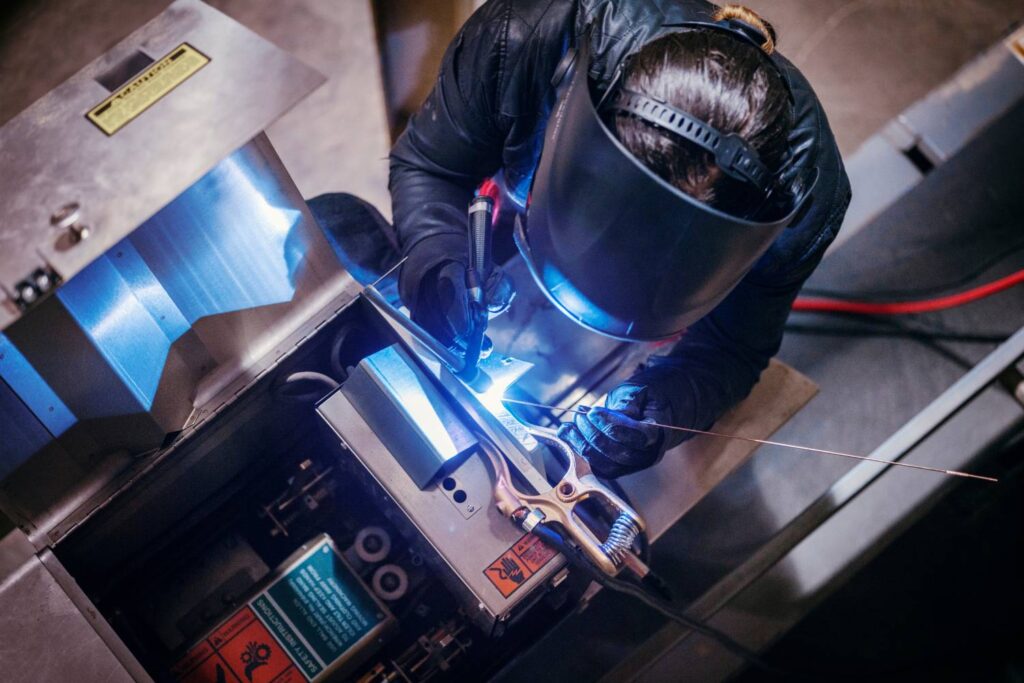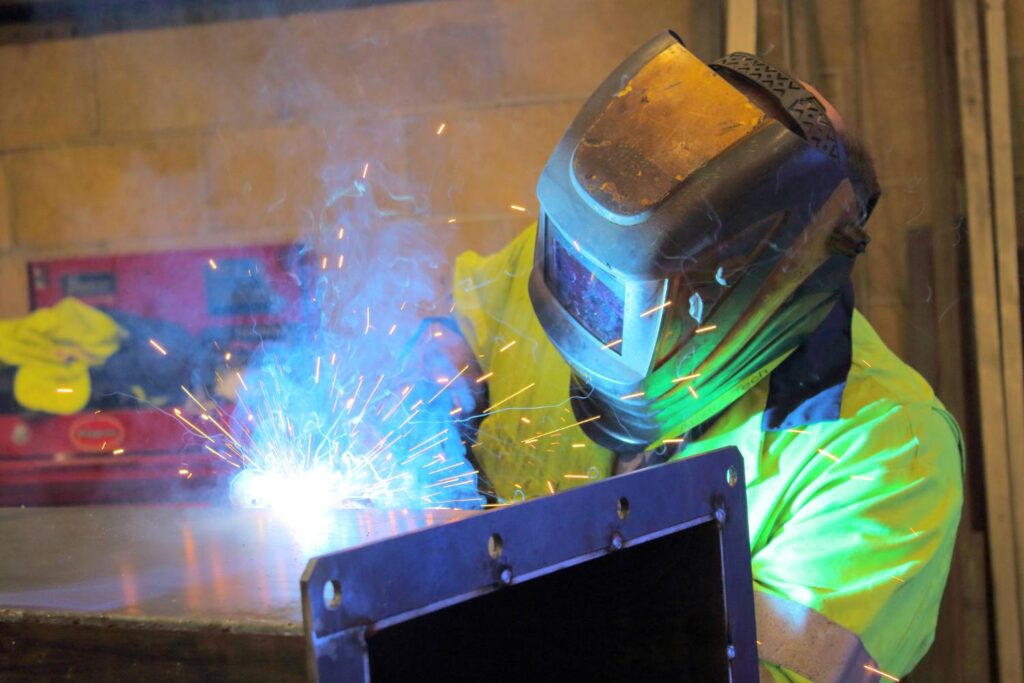This blog explores the complex and intricate world of welding, focusing on the most complicated welding process. It explores the nuances of welding techniques, highlighting the need for precision, skill, and understanding of materials. The blog explores the challenges and intricacies of welding, highlighting the importance of technical knowledge and an artisan's touch in executing flawlessly.
Table of Contents
Understanding Welding Processes
Criteria For Difficulty
- Skill Level Required: Some processes, like TIG welding, demand high manual dexterity, precise control, and the ability to maintain a consistent weld pool, making them more challenging to learn and master.
- Material Sensitivity: The type of material being welded can significantly impact difficulty. For instance, aluminium and stainless steel require more control over heat input and weld pool management, often making TIG welding the preferred but more challenging option.
- Welding Positions: Welding can be performed in various positions, including flat, horizontal, vertical, or overhead. Processes that are more forgiving in flat positions may become exceedingly difficult when welding overhead or vertical positions due to gravity affecting the weld pool.
- Quality and Aesthetics: Processes judged on the appearance of the weld, as well as its structural integrity, such as TIG welding, are often considered more complex. Achieving smooth, clean welds with minimal defects requires a higher skill level.
- Speed vs. Precision: Some projects prioritize speed, making techniques like MIG welding advantageous. However, when precision and quality are paramount, slower, more meticulous methods like TIG welding are necessary, increasing the difficulty.
- Safety Considerations: All welding processes involve risks, but some may pose more significant challenges in ensuring safety. For example, processes that produce significant spatter or fumes, such as SMAW or FCAW, require more stringent safety measures.
- Equipment Complexity: The complexity of the welding equipment and the setup required can also contribute to the difficulty. TIG welding, for instance, involves managing a torch, filler rod, and sometimes a foot pedal simultaneously, adding to its complexity.

The Contenders
In the vast and intricate world of metal fabrication, welding is a fundamental process, bridging gaps between materials and between design and reality. Among the various techniques developed over the years, four have risen as primary contenders, each with unique strengths and applications. These methods—Gas Metal Arc Welding (GMAW/MIG), Gas Tungsten Arc Welding (GTAW/TIG), Shielded Metal Arc Welding (SMAW/Stick), and Flux-Cored Arc Welding (FCAW)—represent the backbone of welding in modern manufacturing and construction.
Gas Metal Arc Welding (GMAW/MIG)
GMAW, commonly known as MIG welding, uses a continuously fed wire electrode and a shielding gas to protect the weld pool from contamination. Renowned for its versatility, MIG welding is suitable for a wide range of metals and thicknesses, making it a go-to method for both industrial applications and hobbyist projects. Its ease of use and efficiency in producing clean welds quickly have cemented its status as a favoured technique, especially for beginners.
Gas Tungsten Arc Welding (GTAW/TIG)
GTAW, or TIG welding, is celebrated for its precision and the high quality of its welds. Utilizing a non-consumable tungsten electrode, TIG welding allows for the meticulous control of the weld pool, enabling the welding of thin materials and achieving aesthetically pleasing results. While it demands a higher skill level and is generally slower than other methods, the superior quality of its welds makes it indispensable for critical applications in the aerospace, automotive, and art industries.
Shielded Metal Arc Welding (SMAW/Stick)
SMAW, known as stick welding, is one of the oldest and most versatile methods. It uses a consumable electrode coated in flux to lay the weld and shield it from contaminants. Stick welding's simplicity and the minimal equipment required make it ideal for construction sites and field repairs. Despite its slower speed and the need for frequent electrode changes, its adaptability to various environments and materials keeps it in constant demand.
Flux-Cored Arc Welding (FCAW)
FCAW combines the advantages of MIG welding's speed with added versatility through a tubular wire filled with flux. This method excels in outdoor applications and on thicker materials, offering deep penetration and a higher deposition rate. While it can produce more spatter and requires cleanup, its effectiveness in challenging conditions and high productivity make it a valuable tool in heavy construction and industrial fabrication.
Tig Welding - The Pinnacle Of Difficulty
The essence of TIG welding lies in its requirement for meticulous control over the welding process. Unlike other methods that allow for variability, TIG welding demands unwavering precision in manipulating the torch and filler rod. The welder must maintain a steady hand to create uniform welds, making it particularly challenging for beginners.
Cleanliness and Preparation
A key factor that adds to the complexity of TIG welding is the necessity for absolute cleanliness. The materials to be welded must be free from any contaminants, as impurities can significantly affect the quality of the weld. This level of preparation requires time and diligence, further contributing to the difficulty of the process.
Heat Control
TIG welding provides the welder unparalleled control over the heat input, allowing for the welding of thin materials and metals with high thermal conductivity, such as aluminium and stainless steel. However, mastering the balance of heat, especially when using a foot pedal for amperage control, is a skill that takes considerable practice to develop.
Manual Dexterity
The dual-hand coordination required in TIG welding, where one hand guides the torch while the other feeds the filler material, and the possible use of a foot pedal to control the current, dramatically demands the welder's manual dexterity. This aspect alone sets TIG welding apart in terms of difficulty, requiring a level of coordination and multitasking ability developed over time.
The Learning Curve
TIG welding's steep learning curve is well-documented. Achieving proficiency requires understanding the theoretical aspects of the process and extensive hands-on practice. The visual and tactile feedback from the weld pool, the arc sound, and the filler material manipulation all contribute to the welder's skill set, which is developed through persistent practice.
Mastering Tig Welding
TIG (Tungsten Inert Gas) welding, also known as GTAW (Gas Tungsten Arc Welding), is a welding process renowned for its precision, versatility, and high-quality finishes. Mastering TIG welding is a journey that requires understanding its complexities, developing essential skills, and continuous practice. Here, we explore the foundational aspects and advanced techniques crucial for anyone aspiring to excel in TIG welding.
Understanding the Basics
Equipment Familiarity: Know your TIG welding machine inside and out. Understanding its settings and how changes affect your weld is crucial. This includes knowing how to adjust amperage, balance control (for AC welding), and pulse settings.
Gas and Material Selection: Selecting the correct type of shielding gas (usually argon or an argon-helium mix) and the correct filler material for the job is essential. The choice depends on the type of metal being welded and the desired properties of the weld.
Tungsten Electrode Preparation: The shape and size of the tungsten electrode play a significant role in the welding process. Learn how to properly grind the electrode to a point (or a truncated tip for AC welding) to effectively control the arc and heat input.
Developing Essential Skills
- Hand-Eye Coordination: TIG welding requires using both hands simultaneously—one to control the torch and the other to feed the filler rod—plus, sometimes, a foot pedal to control the heat. Developing this coordination is critical to producing consistent, high-quality welds.
- Heat Management: Understanding how to control the heat input to prevent warping or burn-through, especially on thinner materials, is vital. This involves managing the arc length and speed of travel and mastering the foot pedal for amperage control.
- Arc Stability: Maintaining a stable arc is essential for TIG welding. Practice keeping a consistent arc length to ensure the weld pool is controlled and the heat input is steady.
Advanced Techniques
- Welding Different Metals: Each metal has unique properties that affect how it should be welded. Mastering TIG welding involves learning the nuances of welding different materials, such as aluminium, stainless steel, and titanium.
- Welding in Various Positions: Welding flat is one thing, but welding in vertical or overhead positions introduces new challenges—practice in all positions to ensure versatility and readiness for any welding task.
- Pulse Welding: Pulse welding can improve control over heat input, reduce distortion, and increase weld quality. Mastering pulse settings allows for working on various projects with varying requirements.
Continuous Learning and Practice
Mastering TIG welding is an ongoing process. The world of welding is constantly evolving, with new materials, technologies, and techniques emerging. Staying informed about industry trends, participating in workshops, and continuous practice are essential for any welder looking to excel in TIG welding.
The Rewards Of Mastering Tig Welding
The journey to proficiency in TIG welding comes with rewards, making it a highly valued skill in the welding community and beyond. Here, we explore the multifaceted benefits of mastering TIG welding for those who dedicate themselves to this artful and technical process.
Unparalleled Weld Quality
One of the most significant rewards of mastering TIG welding is the ability to produce exceptionally high-quality welds. TIG welding allows for greater control over the weld than many other methods, resulting in cleaner, more robust, and more aesthetically pleasing welds. This level of quality is fundamental in industries where weld integrity and appearance are paramount, such as aerospace, automotive, and custom fabrication.
Versatility Across Materials
TIG welding is renowned for its versatility. Mastering TIG welding means having the capability to work with a wide range of materials, including but not limited to stainless steel, aluminium, magnesium, and even exotic alloys. This versatility opens up various opportunities in various sectors, from industrial manufacturing to creative metal art.
Enhanced Career Opportunities
The demand for skilled TIG welders is consistently high across multiple industries. By mastering TIG welding, individuals can unlock enhanced career opportunities, often accompanied by competitive salaries and growth potential. The specialized skill set of a proficient TIG welder is a valuable asset, making them sought after for high-quality, precision welding tasks that other processes cannot fulfil.

Personal Satisfaction and Creativity
Beyond the professional benefits, mastering TIG welding offers deep personal satisfaction. Creating something solid and beautiful with one's hands provides an incomparable sense of accomplishment. Furthermore, TIG welding allows for high creativity, enabling welders to work on custom projects and artistic endeavours that showcase their skill and artistic vision.
Contribution to Innovation
TIG welders play a crucial role in innovation within the welding field and the broader scope of manufacturing and construction. By mastering TIG welding, individuals contribute to the development of new techniques, the improvement of materials, and the creation of groundbreaking products and structures. Their expertise helps push the boundaries of what's possible, leading to advancements in technology and engineering.
Environmental and Safety Advantages
TIG welding is a cleaner process compared to other welding methods. It produces less smoke and fumes, creating a safer and more environmentally friendly working environment. Mastering TIG welding benefits the welder and promotes healthier practices within the industry.
Conclusion
This blog delves into the complex and intricate world of welding, focusing on the most complicated welding process. It highlights the need for precision, skill, and understanding of materials. Several factors influence the process, including skill level, material sensitivity, welding positions, quality and aesthetics, speed vs. precision, safety considerations, and equipment complexity.
Four primary contenders in the metal fabrication industry are Gas Metal Arc Welding (GMAW/MIG), Gas Tungsten Arc Welding (GTAW/TIG), Shielded Metal Arc Welding (SMAW/Stick), and Flux-Cored Arc Welding (FCAW). MIG welding, known for its precision and high quality, is suitable for various metals and thicknesses. TIG welding, on the other hand, is celebrated for its precision and high-quality welds.
Shielded Metal Arc Welding (SMAW/Stick) is an older and versatile welding method that uses a consumable electrode coated in flux to lay the weld and shield it from contaminants. FCAW combines the advantages of MIG welding's speed with added versatility through a tubular wire filled with flux.
TIG welding is the pinnacle of difficulty, demanding meticulous control over the welding process, absolute cleanliness, heat control, manual dexterity, and a steep learning curve. Achieving proficiency requires understanding the theoretical aspects of the process and extensive hands-on practice.
In conclusion, the most complex welding process is TIG welding, which demands precision, skill, and understanding of materials. It is a crucial process in modern manufacturing and construction, with four primary contenders.
TIG welding, or GTAW, is a precision, versatile, and high-quality process. Mastering TIG welding requires understanding its complexities, developing essential skills, and continuous practice. The process involves understanding equipment familiarity, gas and material selection, tungsten electrode preparation, hand-eye coordination, heat management, and arc stability.
Advanced techniques include welding different metals, working in various positions, and pulse welding. Mastering TIG welding is an ongoing process, with new materials, technologies, and techniques emerging. The rewards of mastering TIG welding include exceptional weld quality, versatility across materials, enhanced career opportunities, personal satisfaction and creativity, contribution to innovation, and environmental and safety advantages.
Unparalleled weld quality is a significant reward, especially in industries where integrity and appearance are paramount. TIG welding allows for greater control over the weld, resulting in cleaner, stronger, and more aesthetically pleasing welds. It also offers versatility across materials, allowing for opportunities in various sectors.
Enhanced career opportunities are available for skilled TIG welders, often accompanied by competitive salaries and growth potential. Personal satisfaction and creativity are also significant benefits, as TIG welding allows for custom projects and artistic endeavours.
In conclusion, mastering TIG welding offers numerous benefits, including exceptional weld quality, versatility across materials, enhanced career opportunities, personal satisfaction, and contribution to innovation.
Content Summary
- Welding is an intricate skill crucial across various industries, demanding precision and understanding.
- TIG welding is particularly challenging due to its high skill and precision requirements.
- Mastery in TIG welding demands an artisan's touch and deep technical knowledge.
- TIG welding's difficulty stems from the need for manual dexterity and precise control.
- The material being welded significantly influences the welding process's difficulty.
- AluminiumDue to their sensitivity, aluminium and stainless steel pose particular challenges in TIG welding.
- Welding positions, such as overhead or vertical, can complicate welding.
- Achieving high-quality and aesthetically pleasing welds in TIG welding requires advanced skill.
- Projects requiring precision over speed highlight the complexity of TIG welding.
- Safety considerations are paramount, with some processes posing more significant risks.
- The complexity of welding equipment, especially in TIG welding, adds to the challenge.
- Among welding techniques, four main processes stand out for their unique applications and challenges.
- GMAW/MIG welding is known for its versatility and ease, making it popular among beginners.
- GTAW/TIG welding is celebrated for its high-quality welds and precision.
- SMAW/Stick welding's simplicity and versatility make it ideal for various environments.
- FCAW welding offers advantages in speed and versatility, especially in outdoor applications.
- TIG welding requires meticulous control over the welding process, setting it apart in difficulty.
- Cleanliness and preparation are crucial in TIG welding, adding to its complexity.
- Mastering heat control is essential, particularly when welding thin materials or metals like aluminium.
- The dual-hand coordination required in TIG welding demands significant manual dexterity.
- The steep learning curve in TIG welding is well-documented, requiring extensive practice.
- Mastering TIG welding opens up a world of precision welding, offering numerous rewards.
- High-quality welds achieved through TIG welding are unparalleled in their cleanliness and strength.
- TIG welding's versatility across materials offers broad opportunities in various sectors.
- Skilled TIG welders are in high demand, leading to enhanced career opportunities and competitive salaries.
- Personal satisfaction and creative potential in TIG welding are significant rewards.
- TIG welders contribute to innovation, improving techniques and materials in the welding field.
- The cleaner process of TIG welding offers environmental and safety advantages.
- TIG welding's requirement for a clean work environment underscores its complexity.
- The ability to work with a wide range of materials makes TIG welding a versatile skill.
- The demand for TIG welding in industries like aerospace and automotive highlights its importance.
- Mastering TIG welding is a journey of continuous learning and practice.
- Understanding the basics, such as equipment familiarity and gas selection, is crucial in TIG welding.
- Developing essential skills, like hand-eye coordination and heat management, is critical to mastering TIG welding.
- Advanced techniques, such as welding different metals and mastering various positions, are part of the learning curve.
- Continuous practice and staying informed about industry trends are essential for TIG welding mastery.
- The environmental benefits of TIG welding contribute to a safer and healthier industry standard.
- The aesthetic quality of TIG welds sets a high standard for weld appearance and integrity.
- TIG welding's role in creating solid and durable welds is crucial for structural applications.
- The technical knowledge required for TIG welding underscores its status as a highly skilled process.
- Producing clean, spatter-free welds is a hallmark of TIG welding expertise.
- TIG welding's adaptability to both thin and thick materials showcases its versatility.
- The precision is achievable in TIG welding is essential for applications requiring detailed work.
- The challenge of TIG welding lies in its demand for precise control and steady hands.
- Achieving proficiency in TIG welding is a testament to a welder's dedication and skill.
- The rewards of mastering TIG welding extend beyond the workshop, impacting various industries.
- High-quality outcomes mark TIG Welding's contribution to manufacturing and construction.
- Learning TIG welding is marked by overcoming challenges and achieving mastery.
- TIG welding is a pinnacle of difficulty, offering unique challenges and rewards.
- The journey to mastering TIG welding is a continuous improvement and learning process.
Frequently Asked Questions
The difficulty of a welding process can be determined by several factors, including the level of manual dexterity required, the precision needed to control the weld pool, the sensitivity of materials being welded, and the complexity of the equipment used.
TIG (Tungsten Inert Gas) welding is often considered the most complex welding process because it requires high manual dexterity, precise control over the weld pool, and accurate management of heat input. It also demands cleanliness and preparation of materials, adding to its complexity.
Yes, beginners can learn TIG welding, but it typically has a steeper learning curve than other welding processes. Success in TIG welding for beginners requires patience, practice, and a willingness to learn the nuances of the process.
TIG welding is versatile and can be used on a wide range of materials, including but not limited to stainless steel, aluminium, titanium, and magnesium alloys. Its precision makes it ideal for thin materials and projects requiring high-quality finishes.
Welding position significantly affects the difficulty of the process. Welding in flat or horizontal positions might be manageable, but welding overhead or in vertical positions introduces gravity-related challenges, making it harder to control the weld pool and produce quality welds.

